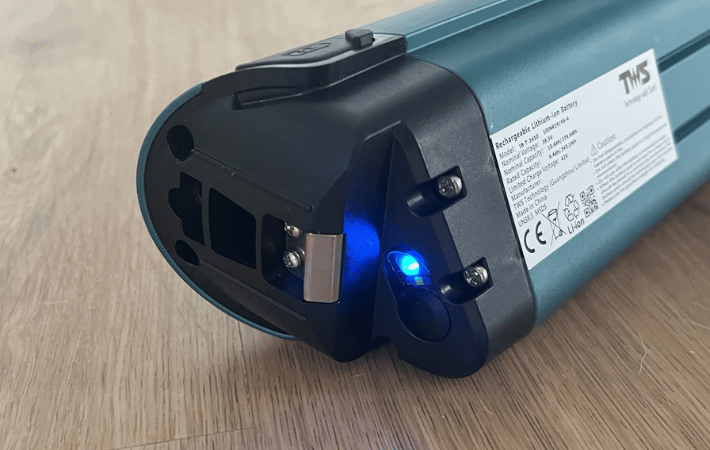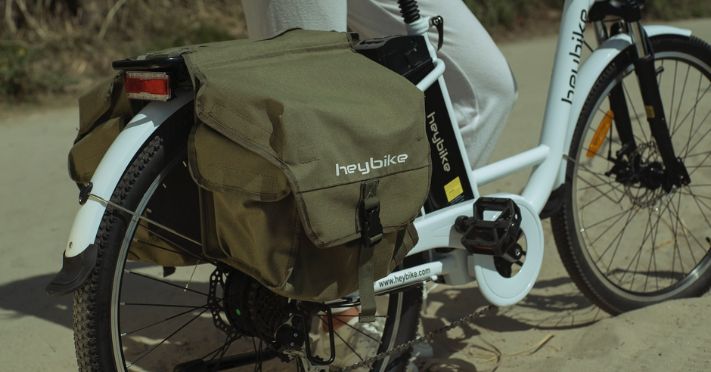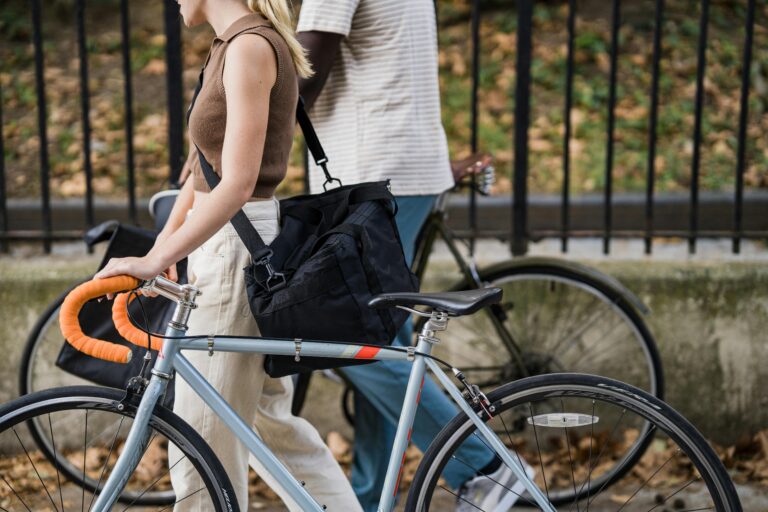Commuting to work on your bike can be the best part of your day — as long as you put safety first to ensure your daily ride goes off without a hitch. Whether you’re a seasoned cyclist or a newbie, we have some safe bike commuting tips to make sure your daily ride rolls smoothly.
How Safe Is Bike Commuting?
There’s no way around it: Biking on the road poses a large risk since you ride alongside much larger and more powerful motor vehicles.
But when you think about it, every mode of transportation has its risks. Either way, a safety-first mindset can help reduce the risks — and an increasing number of local governments are already taking proactive steps in 2024 to manage road traffic and safety.
For example, our 2023 eBikes.org report shows that some cities are becoming friendlier places for cyclists. Seattle and Minneapolis had already taken measures to improve their biking infrastructure, adding bike lanes, tweaking traffic lights to favor bikers, and making intersections safer. Other cities, like Dallas and New York City, aren’t too far behind, with plans already in the works.
Why are so many cities investing in bike infrastructure? Because more people are starting to recognize the benefits of bike commuting.
Benefits of Bike Commuting
Biking to work provides a whole cocktail of benefits. Let’s dig into the details:
- Money Matters: Imagine saving about $2,500 every year just by choosing to pedal over pressing the gas. That’s not pocket change! Our 2023 survey found that cyclists often dodge significant expenses that come with cars, like parking fees, maintenance, and ever-climbing gas prices.
- Stress Less, Produce More: The eBikes.org survey also found that over half the people who switch to biking to work report feeling calmer and more relaxed. This isn’t just good for your mood but also boosts your productivity. Our bike commuter respondents even reported 27% more productivity than their peers who drive.
- Health Is Wealth: Cycling offers a double boost: It helps strengthen your body and maintain mental well-being, reducing the risk of chronic diseases while also clearing your head and lifting your mood.
- Green Power: We all know that riding traditional bikes to work is ecofriendly — but what about e-bikes? Every mile an electric vehicle travels reduces overall carbon emissions, and e-bikes help you do your bit for the planet while staying fit – two birds, one stone. Listen, the bottom line is that it’s good for you, and it’s good for the planet.
Ultimately, the decision is yours to make: Do the advantages tip the scales against the safety concerns?
The good news is that the more we push for improved biking infrastructure and adopt more effective safety measures, the safer bike commuting will become.
Speaking of safety, let’s get into it.
Top 10 Tips to Improve Bike Commuting Safety
Ready to boost your bike commuting safety? Here are some straightforward tips to help you ride smarter and protect yourself on the go.
1. Plan Your Route Wisely

Don’t assume that the normal route you take with your car will also be the best for bike commuting. Take a little time to map out your ride before you saddle up, searching for the safest roads.
Using bike maps or apps can help you find bike routes in your area. For example, Google Maps offers bike-specific navigation. By clicking ‘layers’ and then ‘bike’, you can see different types of bike routes, including trails, roads with bike lanes, bicycle-friendly roads, and dirt paths.
Planning your bike commuting route can help you avoid getting stuck on non-bike-friendly streets and make your ride safer by offering alternatives to busy roads and complicated intersections (although sometimes they’re unavoidable).
It’s also wise to do a trial run of your route to check the road conditions.
Be aware that traffic on your day off may not reflect traffic during commuting days and hours. Still, a trial run can help you familiarize yourself with the route to anticipate different road and traffic conditions. And who knows — you might discover alternative and scenic paths you might not have noticed before!
2. Follow the Rules of the Road
To keep everyone safe, cyclists must, of course, follow the same traffic laws as other drivers. This means stopping at red lights, riding on the right side of the road, and yielding at intersections when necessary.
Specific bike laws vary by state, but some principles apply across the U.S.:
- Give Everyone Their Space: Bikes, cars, and motorcycles alike need a full lane width, so yield to others.
- Keep to the Right: Bikes are usually slower than cars, so they should ride on the right and share the lane with other drivers if wide enough (14’ or more). If not, they can “take the lane” by riding in the middle. It’s worth noting that e-bikes might not be slower than cars in some areas, so they may need the entire lane space.
- Communicate: Make sure to always signal your turns to other road users. While traditional bikes require hand signals, some e-bikes now come equipped with turn signals, providing an extra layer of safety.
3. Stay Alert and Ride Defensively
The unexpected can happen fast on the road. Predictability is your best friend on the road, helping you avoid conflicts and navigate safely through traffic.
Stay alert, ride defensively, and be ready for anything. Riding defensively means doing everything possible to stay seen:
- Avoid Distractions: Don’t wear headphones or, at the very least, only use one earbud. This ensures you can hear traffic sounds and horns, keeping you aware of your surroundings.
- Stay Visible: Make yourself as visible as possible to drivers and pedestrians. For example, you can wear bright or reflective clothing, use the lights on your bike (if available), and ensure your bike is equipped with reflectors.
4. Wear Proper Safety Gear
Speaking of visibility, gear is just as important as how you ride. High-visibility accessories make sure drivers notice you, day or night, while reflective strips and lights are your beacons to help keep you visible. You can buy these things, but many e-bikes now come with reflective wheel strips, as well as front and rear lights.
Don’t underestimate the power of the right gear, especially for work commutes.
Padded clothing can cushion you if you fall, but it might not always be work-friendly. To keep your professional look and stay fresh, consider wearing breathable layers under your work clothes. Or keep a change of clothes at the office.
E-bikes also help by doing most of the heavy lifting — quite literally — which reduces sweat and strain, so you arrive at work ready to go.
Gloves are another important item to consider. They’ll provide you with a better grip, especially in hot or cold weather, so your hands won’t slip. And last but definitely not least, always wear a sturdy helmet to protect you in case of a tumble.
5. Consider Cycling Safety Tech
Technology is advancing quickly, and safety gadgets are no exception. We saw this first-hand at CES 2024, where all sorts of innovative safety gadgets were showcased.
One of our favorite innovations was the sleek airbag vest from Safeware, which acts like a car airbag but for cyclists. The vest instantly inflates when a fall is detected to protect your neck and back.
Vuzix smart glasses also turned heads. They display information from your smartphone onto the lenses to keep your hands on the grips and your eyes on the road.
Another new safety gadget unveiled at CES 2024 was wearable tech from MindMics. Instead of health watches, these earbuds monitor the rider’s heart health for blood pressure management and stress recovery.

E-bike tech has also come a long way in terms of safety. For instance, the Tenways GC0800S casts navigation maps directly to its display screen, allowing you to safely follow directions without fumbling with your phone.
6. Understand Your E-Bike and Local Regulations
If you’re an e-bike commuter, make sure you understand local regulations and whether your state follows the e-bike class system. Each state determines where different classes of e-bikes are allowed and whether or not you need a license.
Some states, such as Kentucky, treat all e-bikes like regular bicycles, while others have more requirements. Take, for instance, Massachusetts. The state classifies all e-bikes that reach 25 mph as “motorized bicycles”. Riders need a license and registration but not insurance. Helmet use is mandatory, and riders must be at least 16. Additionally, the state prohibited e-bikes on public sidewalks or bike paths.
7. Invest in a Quality Commuter Bike
The quality of urban roads can vary greatly, and investing in a commuter e-bike built to withstand your local road conditions is worth every penny. We recommend leaning towards features that foster a comfy and safe bike commuting experience.
Here’s what to look for:
- Durable Construction: Consider a bike built with solid materials that can withstand daily wear and tear without breaking down unexpectedly. Carbon fiber and titanium frames are often popular for durable commuter bikes.
- Strong Wheels: Make sure the wheels can handle rough surfaces to prevent sudden swerving into traffic. Ideally, you want wheels large enough to handle potholes but not too large to become tough to manage.
- Responsive Brakes: Select a bike with reliable brakes to safely navigate traffic and comply with road laws. We’re big fans of hydraulic brake systems.
- Appropriate Speed: A bike that’s too slow can be a hazard in traffic. Consider an e-bike, especially a lightweight model, that helps maintain a steady pace with other cars. The extra power boost can be beneficial for a safer commute on hills and longer rides.
8. Make Sure Your Battery Is Fully Charged

For e-bike commuters, kicking off your day with a full battery is a must. A fully charged battery ensures you won’t lose power when you need it most, especially if your commute involves a lot of uphill stretches or if you’re counting on the throttle to get you through.
You don’t want any unexpected stops or sluggish speeds. It’s all about avoiding sudden decelerations or stops in the middle of the road, which can cause an accident.
Now, before you disregard e-bikes because of the battery, let’s talk about it.
E-bikes aren’t inherently dangerous. Safe e-bike battery charging is possible — and essential. Follow these tips to ensure your e-bike battery is always ready to serve:
- Charge the battery in a temperature-controlled environment (low humidity if possible, and avoid temperature extremes).
- Avoid frequent overcharging (no need to keep it plugged in at all times when not in use).
- Avoid frequent deep discharges. Although you may run the power level down to zero once in a while, doing this regularly can cause damage to the battery.
9. Take Care of Your Bike
Imagine a gear coming loose or getting a flat tire in the middle of your commute — such situations aren’t just inconvenient but dangerous. When repairing your bike, you’re an exposed target, especially if you need to bend down and try to fix something on the side of a road where people may not see you.
Here’s a quick rundown on keeping your bike road-ready:
- Pump up Those Tires: Tire pressure should match your bike and terrain. Urban and city bikes need firmer tires for less rolling resistance and sharper steering, while all-terrain and fat-tire bikes perform better with lower pressure for increased grip on rough surfaces like sand or snow. Adjust your tire pressure accordingly to ensure a safe and responsive ride.
- Keep Those Brakes on Point: It’s important to be able to stop when you need to. Make sure your brakes are responsive and the pads aren’t worn out. It’s a simple check that can make all the difference.
- Maintain That Chain: A dry or gritty chain is a no-go. It should feel smooth when you ride, not crunchy. A quick dab of lubricant on the chain every few weeks helps keep everything moving, with less chance of breaking on the side of a busy road. It’s also worth mentioning that belt-driven e-bikes don’t require any sort of chain maintenance.
10. Carry the Essential Riding Items

Always be ready for the unexpected by packing some essentials for all-around safety. Whether fixing a flat tire, patching up a scrape, or just staying hydrated, make sure you’re covered for whatever your ride throws at you.
To help avoid bike accidents and health issues while riding, here’s what you should have in your cycling kit:
- Basic Repair Kit: Include a spare tube, tire levers, a patch kit, and a multi-tool. These will come in handy if you get a flat or need to adjust something mid-ride.
- First-Aid Kit: Pack bandages, antiseptic wipes, and gauze. It’s always better to be ready to handle minor scrapes or cuts.
- Hydration and Snacks: Of course, water is crucial. But a small, energy-boosting snack like a granola bar or a banana can be just as much a lifesaver on a long stretch.
- Weather-Appropriate Clothing: Always check the weather before you head out. A lightweight, waterproof jacket might be a good addition if rain is on the horizon.
If you’re worried about the weight these safety essentials will add to your ride, using an e-bike can make carrying these items more manageable. The motor facilitates carrying extra cargo.
Keep Your Bike Commute Safe
Let’s be real: Bike commuting does pose a danger. However, you can make your ride to work both pleasant and secure by following these safety tips and gearing up properly.
Remember, the best way to ensure safe bike commuting is through preparation and staying sharp on the road.
Thinking about switching up your commute? Subscribe to our newsletter to get the latest e-bike tips and safety updates delivered right to your inbox! Ready, set, ride!



